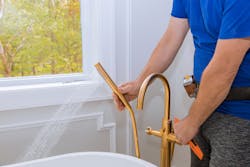Latest Kitchen & Bath Market Index Reveals Uptick
HACKETTSTOWN, NJ — The National Kitchen & Bath Association (NKBA) and John Burns Real Estate Consulting (JBREC) have released their Q2 2020 Kitchen & Bath Market Index (KBMI). The survey of NKBA members in manufacturing, building/construction, design and retail revealed the current health of the industry is rated at 5.9 (on a scale of zero to 10, with zero being poor, five being “normal” and 10 being excellent), up significantly from last quarter’s 4.1. The industry outlook proves even more promising, with future business conditions rated at a 61.9 (on a scale of zero to 100, where 0 is extremely weak and 10 is extremely strong, compared to Q1’s 19.8.
Kitchen and bath professionals list economic uncertainty as their greatest challenge, followed by a potential second wave of COVID-19, the economic recession, consumer confidence and stock market volatility. The impact of COVID-19 and the corresponding economic fallout on the industry remains obvious, but there are signs of optimism ahead. Members cite a pent-up demand for home improvement work, and the industry now expects a full-year’s sales decline of just 4.4% in 2020, a considerable improvement from the 13.7% drop expected when surveyed last quarter.
Nearly half (43%) of companies report a major change in the type of products and services requested by clients — and this might change the industry for the foreseeable future. Trends from those companies reporting changes include:
- An overwhelming 99% see an increase in DIY-project assistance. Homeowners are looking to DIY to save money, which in turn leads to more small-scale projects. Despite increased interest in DIY, revenue is still in decline across all sectors in Q2.
- Shifting price points may be a contributing factor, with 78% noting customer demand for lower prices as consumers face the economic uncertainty brought on by the pandemic. Besides undertaking smaller projects, the average homeowner is looking for more budget-friendly options, lowering the price point of projects of all sizes. This shift may also be partially attributed to older customers delaying projects, perhaps due to concerns about COVID-19 exposure, and more Millennials with smaller budgets turning toward renovations.
- Almost all (98%) of those experiencing shifting demands from clients have seen a rise in the desire for wellness products in response to COVID-19. From no-touch appliances and anti-microbial materials to outdoor kitchens, homeowners are thinking long-term about how they use their kitchens and baths in a world where health and sanitation are top-of-mind. Additionally, more consumers are considering changes to their homes that allow them or their relatives to age in place, like ADA requests and in-law suites, rather than turn to retirement homes and communities.
- More than half (59%) of NKBA members are experiencing supply-chain disruptions, including longer lead times, slowing production and shipping delays — all of which affect their business. Those in flooring (63%), appliances and cabinets (61% each) are most impacted.
“Our members are feeling more optimistic about their business and the state of the kitchen and bath industry than they were last quarter,” said Bill Darcy, NKBA CEO. “While there is an expected revenue decline for 2020, the industry is still valued at $130.8 billion, and as homeowners feel more comfortable returning to showrooms and resuming work in their homes, we’re well-positioned for a steady recovery and eventual rebound in the long run.”
“This quarter’s KBMI notes a trend of homeowners shifting to lower price points for renovation projects, indicating that, while consumers might be spending more than they were in the early stages of the pandemic, they remain cautious,” noted Todd Tomalak, Principal, John Burns Real State Consulting. “Still, the increase in health and future business condition index readings may serve as a positive sign for the rehabilitation of other industries related to housing and discretionary spending.”
All segments of the industry say the virus had less of an impact on their business in Q2 than in Q1. On a scale of one to 10, with one being no impact and 10 being significant impact, the Q2 index reading was 6.4, compared to Q1’s 8.1, but experiences differed broadly by sector. Designers are most affected by COVID-19 (6.7), while retailers are least impacted (6.0), likely due in part to the surge in DIY benefiting some big-box retailers. Manufacturers rated the impact at a 6.5 and building/construction pros at 6.1. Additionally, over one-quarter of designers (28%) say demand is significantly lower than before the pandemic, compared to 15% of retailers, 12% of builders and 11% of manufacturers.
The following findings further illuminate the current state of the kitchen and bath market by sector:
- As evidenced by their take on current business conditions and client demand, designers are still feeling the pinch, although 32% of design firms say clients are requesting more proposals for future projects as a result of being sheltered in their homes, and 82% of designers have been able to make progress on projects through virtual means. One in five note the inability to be in the space they’re designing as an obstacle to remote work, but believe technology will continue to play a role, with a 15.3% YOY growth in e-design expected.
- Improvements in the manufacturing sector: while furloughs continue to impact an average of 41% of workforces in Q2, this is down significantly from 61% in the prior quarter. More than half (54%) of all companies are near full employment, and on average, manufacturers are running at 72% capacity.
- Half of building & construction firms say 80%+ of their active projects are on schedule, a 300%+ improvement from Q1. Project delays are mostly due to concerns about safety and personal finances, but 80% of postponed projects are expected to resume by the end of 2020.
- Foot traffic to retail sales firms dramatically improved in Q2, though it remains below pre-COVID levels. After seeing a drop-off of 75% in Q1, retailers now report a decrease of 34% in foot traffic for the second quarter.
